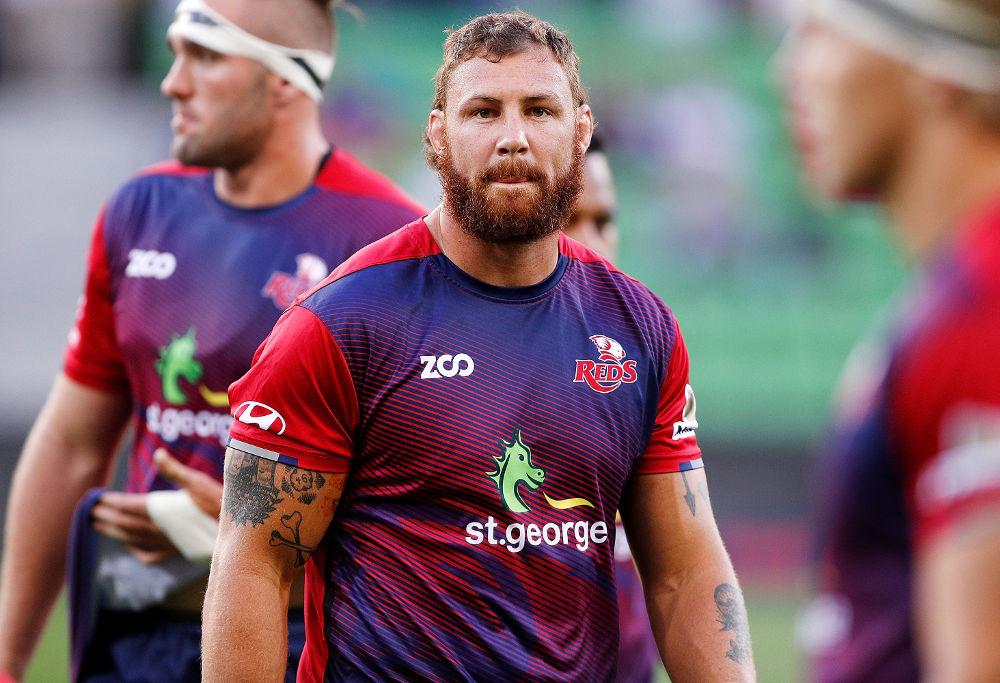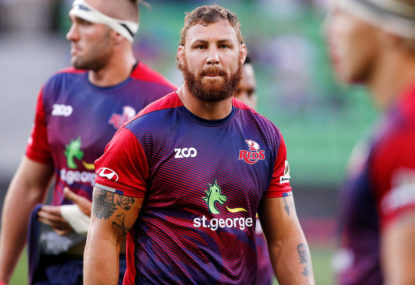If you’re still looking for someone to shake your fist at after what might have felt like a sudden spate of high tackle cards over the first full weekend of Super Rugby, the men in the middle brandishing said cards should be well down the bottom.
They shouldn’t be on the list at all, if you’re honest with yourself.
I’ll let you determine the order, but the people who should be copping your wrath are commentators, coaches, players, and indeed, we fans. The players are top of my list, for whatever that’s worth, closely followed by coaches.
Why not the referees? Because they’re simply applying the agreed interpretations as introduced more than a year ago, on incidents that happen in front of them. The refs – or their assistants, or the TMO – see an incident, and they go through a well-known process in order to reach a prescribed conclusion.
Was the contact high? Was the contact accidental or reckless? Was there excessive force?
It’s cruelly referred to as a box-ticking exercise, but the methodical working through the process and the answers generated along the way ultimately decide the sanction. And it’s not just one man’s opinion, it’s a conversation involving the whole officiating team.
A+B+C+D = “I’m thinking that’s a yellow card, do you agree?” “Yes, I do.”
We all know how the process works.
[latest_videos_strip category=”rugby” name=”Rugby”]
And though commentators, coaches, players, and indeed, fans, might have temporarily forgotten about it over a long summer of cricket and beaches and Christmas cheer, the current application of the high tackle Laws were first introduced by World Rugby in November 2016.
They were first used in Super Rugby in Round 1, 2017. I first wrote about it last January.
Which is why anyone suggesting this ‘sudden crackdown’ on high contact is a recent thing needs to be laughed at.
Coaches have had two full pre-seasons to reinforce the changes. Players have had that same amount of time and a full season playing under said changes to alter techniques. Fans have had more than a year to get used to the law amendments, and commentators have had that same time to ensure they know what they’re talking about.
Though initially I was a little surprised to hear referee Brendan Pickerill describe the force of Scott Higginbotham’s contact with Matt Philip’s head as “considerable”, as soon as he and TMO Ian Smith worked through the process together in full agreement – contact with the head, no arms in the tackle, and with considerable force, was their conclusion – there was only one way this was going to end for Higginbotham.
Lukhan Tui will learn of his fate on Tuesday night, after being cited for his lift-and-dump tackle on Will Genia, and I suspect he’ll be looking at a similar ban to Higginbotham’s. A popular line of thought, which I tend to agree with, is that Tui’s looked the worse of the two; there might even be merit in the theory that only Genia getting straight up and Higginbotham’s red card thirteen minutes earlier allowed Tui to return to the play after receiving a yellow card.
Where was Lachlan Boshier supposed to tackle Ryan Crotty legally, the Sky Sport commentators in New Zealand asked on Saturday evening? How about under Crotty’s right shoulder, instead of on top of it. Boshier found himself caught up in the ‘accidental contact’ part of the new high tackle interpretations, specifically where:
“A player makes accidental contact with an opponent’s head, either directly or where the contact starts below the line of the shoulders.”

(Photo by Daniel Pockett/Getty Images)
A penalty is the minimum sanction in such cases, but in deciding that foul play had occurred, referee Ben O’Keeffe then had to rule on foul play occurring in the act of a try being scored.
Law 8.3 (Penalty try) makes this clear: “A penalty try is awarded between the goal posts if foul play by the opposing team prevents a probable try from being scored, or scored in a more advantageous position. A player guilty of this must be cautioned and temporarily suspended or sent off.”
Had Boshier’s tackle on Crotty occurred back upfield, or indeed, stopped him short of the line, the likely result was a penalty only for accidental high contact. But because Crotty grounded the ball, the incident was rightly magnified.
Higginbotham received a three-week suspension for his indiscretion, discounted down from six weeks for his good record, for no apparent injury to Philip, and for pleading guilty at the first opportunity.
And when viewed along side some reasonable well-known recent examples, three weeks looks about right.

Sonny Bill Williams received four weeks for his hit during the Lions series (which somehow, confusingly, became closer to seven weeks by the time he actually returned), and Sekope Kepu is still serving the last of his three weeks for his ugly Spring Tour clean-out against Scotland. Higginbotham’s is absolutely on par with these incidents.
Spiro floated the idea on Monday of reforming the red card regulations, but this is something I could not disagree with more. For one thing, it’s a classic case of tweaking the effect and leaving the cause untouched, and that’s nonsense.
The whole point of the crackdown on high contact and making the head sacrosanct is to increase the disincentive to infringe. Watering down the red card sanction does the opposite of that.
If after a year, players still haven’t worked out that high contact could lead to a send off and several weeks off, then I have no sympathy for them at all.
And the same applies to coaches, for that matter. Brad Thorn tried to downplay Higginbotham’s incident with comparisons to his playing days at Newcastle’s then Marathon Stadium, but with the greatest of respect, that is literally decades-old thinking that no longer applies. The game has changed and so must attitudes across the board.
Here’s a bigger question for Thorn. Why, after conceding the most yellow cards and the most foul play penalties in all of Super Rugby in 2017, are the Reds’ players’ tackling techniques still skating so close to the high tackle laws more than twelve months since the new interpretations were introduced?
That’s where the real reform is needed.































































































